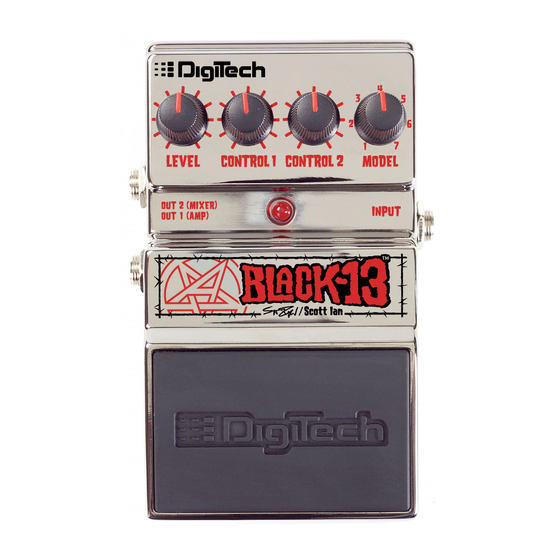DigiTech Scott Ian Black-13 Manual do Proprietário - Página 6
Procurar online ou descarregar pdf Manual do Proprietário para Pedal de música DigiTech Scott Ian Black-13. DigiTech Scott Ian Black-13 11 páginas. Artist series pedal
Também para DigiTech Scott Ian Black-13: Especificação (2 páginas)

"Protest and Survive," Anthrax – Attack of the Killer B's
MODEL 4.
This is based on the raw, more diffuse distortion tone Scott
used for the intro to "Protest and Survive". Use the
CONTROL 1 knob to boost or cut the low frequencies.
Use the CONTROL 2 knob to boost or cut the high
frequencies.
MODEL 5.
"Room For One More," Anthrax –
Scott acheived this tone by combining three amps ( a
Marshall
TM
JCM 800, a Matchless
with a T.C. Electronics
the CONTROL 1 knob to boost or cut the low
frequencies. Use the CONTROL 2 knob to boost or cut
the high frequencies.
"What Doesn't Die," Anthrax – We've Come For You All
MODEL 6.
This effect gives your guitar the more modern distortion
tone Scott got with a Randall® amp and a BBE® Sonic
Maximizer® processor. Use the CONTROL 1 knob to
boost or cut the low frequencies. Use the CONTROL 2
knob to boost or cut the high frequencies.
Sound of White Noise (1993)
TM
, and a Marshall Jubilee
TM
Booster/Distortion processor. Use
(1991)
MODEL 7.
TM
)
(2003)
"Finale," Anthrax – State of Euphoria
Model 7 is based on pitch-shifted delay effect Scott used
during the opening muted bar chords of the song "Finale".
The CONTROL 1 knob changes the amount of pitch-
shifting in the delayed repeats. Setting the CONTROL 1
knob fully clockwise will shift each repeat up 12 semitones,
while setting the CONTROL 1 knob fully counter-
clockwise will shift each repeat down 12 semitones. Setting
the CONTROL 1 knob to the 12 o'clock position
recreates the same pitch shift that Scott used in the original
recording; if you want no pitch shift, set the CONTROL 1
knob to the 2 o'clock position (approximately).The
CONTROL 2 knob adjusts the delay time of the pitch-
shifted repeat; turn it clockwise for longer delays, or
counter-clockwise for shorter delays.
(1988)
